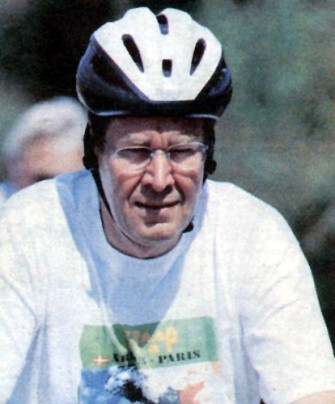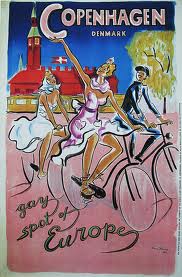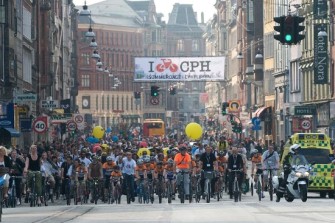
Meet Denmark, the International Bicycle Darling: Member of the Month

Just recently, Denmark has become an international bicycle darling, but the Danish bicycle girls have always been an attraction. Credit: Mikael Colville-Andersen/Copenhagenize
When the bicycle came to Denmark
As in many other countries, the bicycle came to Denmark in the late 1800s. This mechanical invention created a lot of debate – “the bicycle war” as one national newspaper called it. Some saw the potential right away and declared that those who cycled “will be much better at enjoying their lecture and their music in the evening than the rest, for by exercising their bodily strengths also their mental abilities will be enhanced and enlivened” (Danish Sport Tidings, 1889), while others found the bicycle the devil of a modern world. One priest publicly announced that there are three things that he simply would never allow his daughter: “to smoke, to study and to bicycle!” Others were outraged by the fact that more and more “ugly and skinny legged cyclists” appeared in the streets and worst of all “women who sat astride two-wheeled cycles – had these women no dignity?”
It came and it stayed
Not everybody welcomed the bicycle into the Danish culture – but thankfully two wheels prevailed! This is,
let’s not forget, largely due to more than 100 years of bicycle advocacy from the Danish Cyclists’ Federation, one of ECF’s members.
Up until the 50s, bicycling became an increasingly dominant mode of transportation and pedaling blond girls in flowing robes were a typical picture on Danish tourist posters. But when the economic boom of the sixties came rolling in so did the automobile, finding its way into every Dane’s ordinary life. Urban planners started planning for the car and by 1972 the number of Danish cyclists was at an all-time low. Luckily Denmark was blessed with two oil crises and enormous bicycle demonstrations, orchestrated by members of the Danish Cyclists’ Federation, in the late seventies. Slowly but surely cycling became a natural part of planners and citizen’s life.
Tailwind on all bicycle paths
It can be hard to explain the Danes relationship to the bicycle. The response is normally something along the lines of: “I don’t know - it’s just something I do”. Don’t be fooled though! Bicycling plays a big role in the Danish consciousness.

The former Prime Minister, Poul Nyrup Rasmussen, was publicly mocked because of wearing this helmet. Credit: Unknown
In 1974 “Cykelsangen - jeg er så glad for min cykel” (The Bicycle Song - I’m so happy for my bike) by the beloved singer-songwriter, Povl Kjøller, instantly became a Danish hit. (If you find a Dane who cannot at least hum the melody of that song you should immediately report it to ECF).
Twenty years later, in 1994, a Danish comedian, Jacob Haugaard, ran for election at the Danish parliament as a practical joke. One of his most popular political promises was tailwind on all bicycle paths. The man won and worked as a Danish politician for four years.
Meanwhile, in 1995, Danish Prime Minister, Poul Nyrup Rasmussen, was publicly mocked by the whole nation, not for a sex scandal, but because he wore a bicycle helmet that was too small to a political demonstration. Even though the Danes have a hard time explaining how or why, the two-wheeler has indeed become a part of the Danish mindset.
And now, after the turn of the millennium, Denmark’s bike culture has been placed in the international spotlight. As modest as the Danes try to be, they still secretly gorge themselves on the attention. But why did the Danish bike culture suddenly become so popular and how will Danish bicycle culture evolve in the future? EFC asked its three Danish members, the Danish Cyclists’ Federation, Copenhagenize Consulting, and De Frie Fugle, those questions. Here are the members of the months perspective on the pedaling phenomenon in Denmark.
Why the sudden national and international spotlight?
When it comes to the sudden international attention Danish Cyclists’ Federation believes that the most recent bicycle popularity push happened in the late last decade. The challenges of reducing CO2 emissions and improving health conditions put cycling back on the political agenda. DCF also believes that the “Danish Bicycle trademark” has grown stronger because of the international demand for solutions that tackle urban challenges like congestion, health and climate problems. De Frie Fugle seems to partly agree that it has to do with a change of political focus and agenda, but also thinks, like Copenhagenize Consulting, that change was caused by the social media’s bottom-up effect.
“The power of social media created the focus. Back then few hotels had bicycles for rent for their guests and little material focusing on bicycles was available at the tourist office. We googled "bike Copenhagen", "bicycle Copenhagen" back in early 2007 and there were few hits on Google. If you google those words now, it's a different story. Because of the focus placed on Copenhagen as a bicycle city through blogs, the bicycle has now become a major branding angle for the city and the word we coined - Copenhagenize - is as well-known as Cycle Chic throughout the world”, says Copenhagenize Consulting.
What are the pros and cons about the Danish bicycle culture in the future?
All three members are looking forward with relative confidence regarding to the future of Danish bicycle culture. “Right now there is a window of opportunity to improve and develop the bicycle conditions, because of the recession, the environmental and climate debate” says DCF, while Copenhagenize Consulting emphasizes the importance of a continuous positive branding of cycling. They think that the perception of cycling, in Denmark, has suffered due to helmet promotion and fights to reverse that trend and to promote cycling positively once again.

Hopefully the Danish bicycle girls will be just as chic in the future! Credit: Mikael Colville-Andersen
The challenges as De Frie Fugle sees them is “to make people cycle more also in the countryside” and this calls for “more elegant technical solutions […] including electrical bikes, bicycle bridges and sheltered bike tracks etc.”
Top 3 best practices when developing a bicycle culture?
- Everyone agrees on the number one best practice: You have to make cycling the fastest and easiest way to get around. ‘A2Bism’ as Copenhagenize calls it or “cycling for practical reasons – not ideological reasons” as DCF puts it.
- The number 2 best practice is a little less unequivocal: De Frie Fugle emphazises the importance of intermodality, simply “[continuing]to develop cycling and public transport to cooperate”, while Copenhagenize Consulting believes that “marketing bicycle culture positively - like any other product - is vital.” DCF sees the future in children: “Teach and encourage children to ride a bike – then they will do it when they grow up.”
- There’s many ways of saying it, but once again the ECF members seem to (somewhat) agree on the number 3 best practice: “Address bicycles as being part of the solution – not the problem” says DCF, while Copenhagenize Consulting wants traffic calming and lower speed limits (30km/h). De Frie Fugle goes a little further and calls for more “free zones in town where the bike is the main transport, like in cities of Holland and like in Christiania in Copenhagen.”
ECF’s members are a diverse bunch to say the least. But one thing is for sure, they’re all about getting more people on bicycles. Denmark’s cycle advocates have done an extraordinary job at doing so, and there is a reason that Copenhagen is referred to as the globe’s cycling capital. (Just don’t tell the Dutch).”
Further readings:
Full version of Questions and Answers by the members:
Copenhagenize Consulting_QandA
Danish bicycle history:
Aakjær, Svend: Historiske Meddelelser om København. Københavns Kommunalbestyrelse, 1947 (In Danish)
Jensen, Niels and Larsen, Jens Erik: Cycling in Denmark - from the past into the future. Road Directorate, Ministry of Transport Municipality of Copenhagen, 1989
Knudsen, Walther and Krag, Thomas: På cykel i 100 år - Dansk Cyklist Forbund 1905-2005. DCF, 2005 (In Danish)
Vanman, Cecilia: Copenhagen City of Bicycles. Nyt Nordisk Forlag/ Arnold Busk 2010 (In Danish as well as English)
Museum of Copenhagen: Exhibition Copenhagen by Bicycle:
http://www.copenhagen.dk/en/whats_on/previous_special_exhibitions/copenhagen_by_bicycle
Cycling Embassy of Denmark: http://www.cycling-embassy.dk/cycling-history/
Sidsel Birk Hjuler is the communications assistant at ECF. Sidsel has a MA in Modern Culture and Cultural Communication, University of Copenhagen, and has been studying emerging bicycle cultures and the cycling experience of different international city infrastructures in sociological perspective.
She thinks that cycling, as a mode of transportation, significantly improves urban life.
Contact the author
Recent news!
Upcoming events
Contact Us
Avenue des Arts, 7-8
Postal address: Rue de la Charité, 22
1210 Brussels, Belgium













